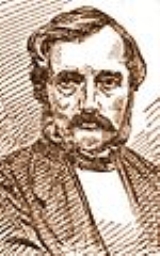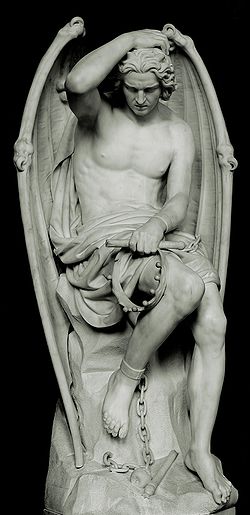
Guillaume Geefs
Encyclopedia
Guillaume Geefs also Willem Geefs, was a Belgian
sculptor
. Although known primarily for his monumental works and public portraits of statesmen and nationalist figures, he also explored mythological subject matter, often with an erotic theme.
(1808–1885, winner of the Prix de Rome
in 1836) and Jean Geefs (1825–1860, and winner of the prize in 1846). Guillaume first studied at the Royal Academy of Fine Arts Antwerp
under the late–Flemish Baroque
sculptor Jan Frans van Geel and his son, Jan Lodewijk van Geel, who was also a sculptor. He completed his training under Jean-Etienne Ramey at the École des Beaux-Arts
in Paris and began exhibiting his work in 1828.
In 1829, Geefs traveled to Italy. When he returned to Antwerp, he began teaching at the art academy. During the 1830s, he executed the colossal work Victims of the Revolution at Brussels
, as well as numerous statue
s and bust
s. In 1836, he married Isabelle Marie Françoise Corr, a Brussels-born painter of Irish descent known professionally as Fanny Geefs
. In the mid-19th century, the sculptor Guillaume-Joseph Charlier was an assistant to him and his brother Joseph.
The Geefs family played a leading role in the craze for public sculpture that followed Belgian independence in the 1830s
, producing several propagandistic monuments that emphasized a "historical continuity of the southern Low Countries in the new independent state."
in monumental works such as General Belliard
and Frédéric de Mérode (erected in Brussels, 1836 and 1837) and Peter Paul Rubens (Antwerp, 1841). He was prolific in producing tombs, pulpits, statues, busts, and sculpture groups.
 The works of Guillaume Geefs include:
The works of Guillaume Geefs include:
Belgium
Belgium , officially the Kingdom of Belgium, is a federal state in Western Europe. It is a founding member of the European Union and hosts the EU's headquarters, and those of several other major international organisations such as NATO.Belgium is also a member of, or affiliated to, many...
sculptor
Sculpture
Sculpture is three-dimensional artwork created by shaping or combining hard materials—typically stone such as marble—or metal, glass, or wood. Softer materials can also be used, such as clay, textiles, plastics, polymers and softer metals...
. Although known primarily for his monumental works and public portraits of statesmen and nationalist figures, he also explored mythological subject matter, often with an erotic theme.
Life
Geefs was born at Antwerp, the eldest of six brothers in a family of sculptors, the best-known of whom are Joseph GeefsJoseph Geefs
Joseph Germain or Jozef Geefs was a Belgian sculptor. His brothers Guillaume Geefs and Jean Geefs were also sculptors.-Life:...
(1808–1885, winner of the Prix de Rome
Prix de Rome
The Prix de Rome was a scholarship for arts students, principally of painting, sculpture, and architecture. It was created, initially for painters and sculptors, in 1663 in France during the reign of Louis XIV. It was an annual bursary for promising artists having proved their talents by...
in 1836) and Jean Geefs (1825–1860, and winner of the prize in 1846). Guillaume first studied at the Royal Academy of Fine Arts Antwerp
Royal Academy of Fine Arts Antwerp
The Royal Academy of Fine Arts Antwerp is an art academy located in Antwerp, Belgium. It is one of the oldest of its kind in Europe. It was founded in 1663 by David Teniers the Younger, painter to the Archduke Leopold Wilhelm and Don Juan of Austria...
under the late–Flemish Baroque
Flemish Baroque painting
Flemish Baroque painting is the art produced in the Southern Netherlands between about 1585, when the Dutch Republic was split from the Habsburg Spain regions to the south by the recapturing of Antwerp by the Spanish, until about 1700, when Habsburg authority ended with the death of King Charles II...
sculptor Jan Frans van Geel and his son, Jan Lodewijk van Geel, who was also a sculptor. He completed his training under Jean-Etienne Ramey at the École des Beaux-Arts
École des Beaux-Arts
École des Beaux-Arts refers to a number of influential art schools in France. The most famous is the École nationale supérieure des Beaux-Arts, now located on the left bank in Paris, across the Seine from the Louvre, in the 6th arrondissement. The school has a history spanning more than 350 years,...
in Paris and began exhibiting his work in 1828.
In 1829, Geefs traveled to Italy. When he returned to Antwerp, he began teaching at the art academy. During the 1830s, he executed the colossal work Victims of the Revolution at Brussels
Brussels
Brussels , officially the Brussels Region or Brussels-Capital Region , is the capital of Belgium and the de facto capital of the European Union...
, as well as numerous statue
Statue
A statue is a sculpture in the round representing a person or persons, an animal, an idea or an event, normally full-length, as opposed to a bust, and at least close to life-size, or larger...
s and bust
Bust (sculpture)
A bust is a sculpted or cast representation of the upper part of the human figure, depicting a person's head and neck, as well as a variable portion of the chest and shoulders. The piece is normally supported by a plinth. These forms recreate the likeness of an individual...
s. In 1836, he married Isabelle Marie Françoise Corr, a Brussels-born painter of Irish descent known professionally as Fanny Geefs
Fanny Geefs
Fanny Geefs was a Belgian painter of Irish descent.Born Isabelle Marie Françoise Corr in Brussels, she studied art as a child. In the 1830s she studied with François-Joseph Navez. As well as portraiture, she painted religious and historical scenes such as Our Lady Appearing to the Oppressed which...
. In the mid-19th century, the sculptor Guillaume-Joseph Charlier was an assistant to him and his brother Joseph.
The Geefs family played a leading role in the craze for public sculpture that followed Belgian independence in the 1830s
Belgian Revolution
The Belgian Revolution was the conflict which led to the secession of the Southern provinces from the United Kingdom of the Netherlands and established an independent Kingdom of Belgium....
, producing several propagandistic monuments that emphasized a "historical continuity of the southern Low Countries in the new independent state."
As artist
Geefs' early work has been characterized as "predominately elegiac in mood." By the end of the 1830s, however, he developed a powerful, spare realismRealism (visual arts)
Realism in the visual arts is a style that depicts the actuality of what the eyes can see. The term is used in different senses in art history; it may mean the same as illusionism, the representation of subjects with visual mimesis or verisimilitude, or may mean an emphasis on the actuality of...
in monumental works such as General Belliard
Augustin Daniel Belliard
Augustin Daniel Belliard, comte Belliard et de l'Empire was a French general.Belliard became an officer between 1792 and 1793 under Dumouriez in Belgium...
and Frédéric de Mérode (erected in Brussels, 1836 and 1837) and Peter Paul Rubens (Antwerp, 1841). He was prolific in producing tombs, pulpits, statues, busts, and sculpture groups.
Works

- Frédéric de MérodeHouse of MerodeThe princely house of Merode is one of the most important houses of the Belgian nobility.The surname of the family and the name of the House is mostly written de Mérode in but was originally von Merode due to the German descent of the House...
(1833/1837), tomb monument, "noted for its naturalness and lack of idealization." - General Belliard (1836), rue Royale, Brussels; more than life-size
- Victims of the Revolution (1838), an allegorical monument commemorating the Belgian RevolutionBelgian RevolutionThe Belgian Revolution was the conflict which led to the secession of the Southern provinces from the United Kingdom of the Netherlands and established an independent Kingdom of Belgium....
- Leopold ILeopold I of BelgiumLeopold I was from 21 July 1831 the first King of the Belgians, following Belgium's independence from the Netherlands. He was the founder of the Belgian line of the House of Saxe-Coburg-Gotha...
, considered one of the most important works of public art in Belgium in the 19th century; a stamp issued in 1981 commemorates this statue; it may be viewed online - Treurende Adonis (1839), white marble of AdonisAdonisAdonis , in Greek mythology, the god of beauty and desire, is a figure with Northwest Semitic antecedents, where he is a central figure in various mystery religions. The Greek , Adōnis is a variation of the Semitic word Adonai, "lord", which is also one of the names used to refer to God in the Old...
in mourning; view online - A small sculpture of a young sleeping angel, privately held and not authenticated (but signed by the artist), found in 1993 in an abandoned house in Brussels; see Renderosity Digital Art Community or archive
- Grétry (1842), bronze statue of the composer, in front of the opera house in Liège
- Le génie du malLe génie du malLe génie du mal or The Genius of Evil, known informally in English as Lucifer or The Lucifer of Liège, is a religious sculpture executed in white marble by the Belgian artist Guillaume Geefs...
, a LuciferLuciferTraditionally, Lucifer is a name that in English generally refers to the devil or Satan before being cast from Heaven, although this is not the original meaning of the term. In Latin, from which the English word is derived, Lucifer means "light-bearer"...
in white marble for the Cathedral of St. Paul, Liège - CharlemagneCharlemagneCharlemagne was King of the Franks from 768 and Emperor of the Romans from 800 to his death in 814. He expanded the Frankish kingdom into an empire that incorporated much of Western and Central Europe. During his reign, he conquered Italy and was crowned by Pope Leo III on 25 December 800...
(1843), statue in the Basilica of Saint ServatiusBasilica of Saint ServatiusThe Roman catholic Basilica of Saint Servatius, situated in Maastricht at the Vrijthof square, is a mainly Romanesque church dedicated to Saint Servatius.- History :...
in MaastrichtMaastrichtMaastricht is situated on both sides of the Meuse river in the south-eastern part of the Netherlands, on the Belgian border and near the German border... - The Roman Gladiator, located opposite the M. H. de Young Memorial MuseumM. H. de Young Memorial MuseumThe M. H. de Young Memorial Museum, commonly called simply the de Young Museum, is a fine arts museum located in San Francisco's Golden Gate Park. It is named for early San Francisco newspaperman M. H...
in San Francisco to mark the ground-breaking for the 1894 Mid-Winter Exposition; see online. - Le lion amoreux or The Amorous Lion (1851), marble, Royal Museums of Fine Arts of BelgiumRoyal Museums of Fine Arts of BelgiumThe Royal Museums of Fine Arts of Belgium , is one of the most famous museums in Belgium.-The museum:...
, see online; small bronze version online.

